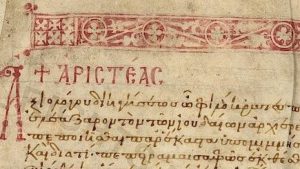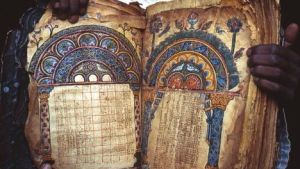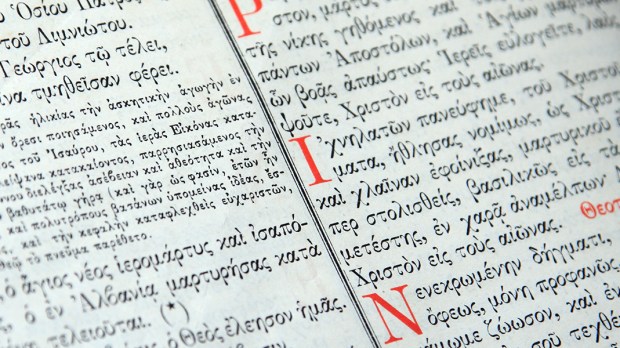Christianity without the Bible is difficult to imagine. But in fact, for the first 300 years of Christianity, the Bible did not exist. That is, if we understand the Bible as we do today: as a single compilation containing all of the texts Christianity considers sacred.
The creation and compilation of the Bible was a long process. Leaders of the early Church sifted through numerous manuscripts and discerned, using several different historical, doctrinal, and theological criteria, which books were to be kept and included in the canon, and which books were to be set aside. This process of establishing a canon of Scripture differed for the Old and New Testament.

Read more:
What is the Septuagint and why is it important?
Formation of the “Old Testament”
What Christians refer to as the “Old Testament” is essentially an ancient compilation of the Jewish Sacred Scriptures, the Tanakh, the Hebrew Bible. These holy texts (the Torah, the books of the Prophets, and the “Writings”) developed over time and were at first handed over orally from one generation to the next until they were finally written down and preserved.
About 200 years before the birth of Jesus, there arose a Greek translation of the Hebrew texts that became widely accepted as a legitimate (and even inspired) translation. Tradition relates how King Ptolemy II of Egypt ordered a translation and invited Jewish elders from Jerusalem to prepare the Greek text. Seventy-two elders, six from each of the 12 tribes, arrived in Egypt to fulfill the request. Another tradition recounts how the translators were all put in separate rooms and told to produce their own separate text. When the task was completed the translators compared them all and it was discovered that each one was miraculously identical to the others.
The result became known as the Septuagint (from the Greek word for 70) and was especially popular among Greek-speaking Jews. This led to the Septuagint becoming a primary source for the Gospel writers and many other early Christians, who wrote their own works in Greek.

Read more:
How many times has the Bible been translated?
When formulating the official canon of Scripture the Church looked to the Septuagint to discern which books to retain. But the Catholic canon of the Old Testament also includes some texts and additions to books (for example, the Books of Judith and Tobit, Wisdom and Sirach) originally written in Greek, not Hebrew, and therefore not considered part of the Jewish Scriptures,though respected and read by Jews at the time.
Formation of the New Testament
Various writers wrote down in the years following Jesus’ death the many stories circulating about the Messiah. These writers were either apostles, or friends of apostles who knew Jesus very well. They witnessed the events or interviewed people who had, and sought to preserve the life and teachings of Jesus Christ in written form.
As time passed by, copies of these works were spread and various Christian communities gathered them to be read during the Sunday celebration of the Mass. Copies of St. Paul’s letters were also disseminated and were regarded by the communities as inspired by the Holy Spirit.
A document from the Second Vatican Council, Dei Verbum, confirms this process of how the New Testament was formed, specifically the Gospels:
The sacred authors wrote the four Gospels,selecting some things from the many which had been handed on by word of mouth or in writing, reducing some of them to a synthesis, explaining some things in view of the situation of their churches and preserving the form of proclamation but always in such fashion that they told us the honest truth about Jesus. For their intention in writing was that either from their own memory and recollections, or from the witness of those who “themselves from the beginning were eyewitnesses and ministers of the Word” we might know “the truth” concerning those matters about which we have been instructed.

Read more:
What is the best edition of the Bible for Catholics?
Already by the time of Saint Irenaeus (A.D. 182-88) there is mention of the “quadriform” Gospel, referring to the four Gospels of Matthew, Mark, Luke and John.
During the fourth century the need arose to officially codify the Bible, which by this point was already starting to come together. Some historians believe that part of the motivation to produce an official canon came from Emperor Constantine who commissioned 50 copies of the sacred scriptures for the Bishop of Constantinople. The approval of which books to include started with the Council of Laodicea in 363, was continued when Pope Damasus I commissioned St. Jerome to translate the Scriptures into Latin in 382, and was settled definitely during the Synods of Hippo (393) and Carthage (397).
The goal was to dismiss all erroneous works that were circulating at the time and instruct the local Churches as to which books could be read at Mass.

Read more:
The oldest, most complete Gospel book on Earth is in Ethiopia
The Church has always believed that this lengthy process was guided by the Holy Spirit. As the Catechism of the Catholic Church explains, the “Holy Mother Church, relying on the faith of the apostolic age, accepts as sacred and canonical the books of the Old and the New Testaments, whole and entire, with all their parts, on the grounds that, written under the inspiration of the Holy Spirit, they have God as their author, and have been handed on as such to the Church herself.”
Visit the slideshow below to discover a 14th century Bible, especially made for the illiterate.


